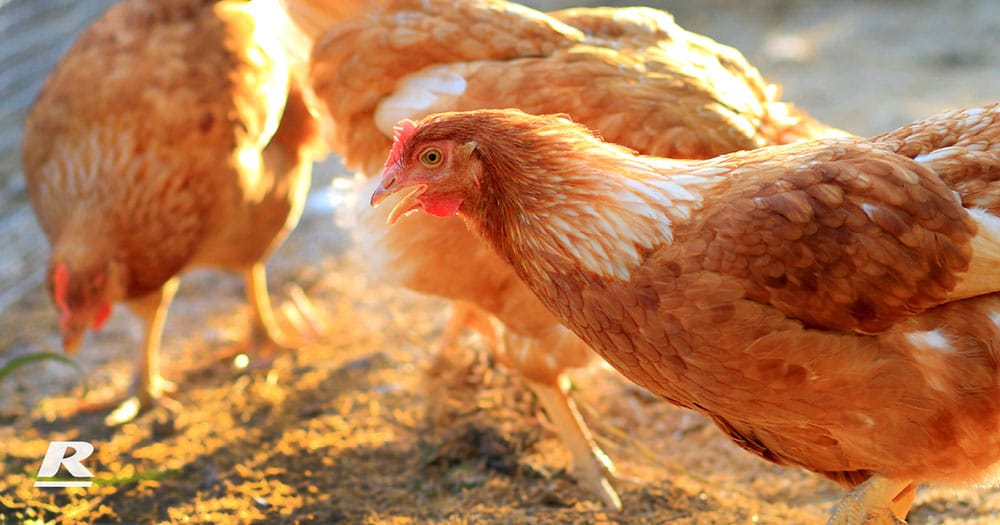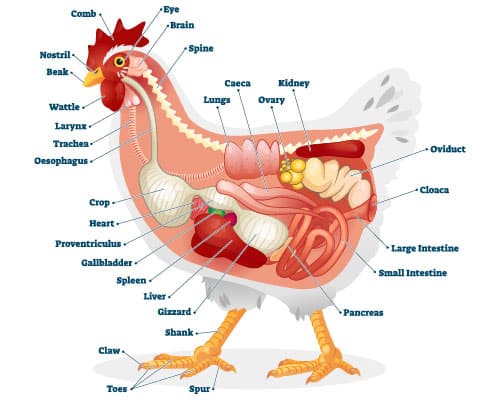Diet quality and gut health in Poultry
The gut or gastrointestinal tract (GIT) of poultry extends from the beak to cloaca. It has three main functions to:
- Digest (breakdown) the nutrients in poultry feed into smaller chemicals that can be absorbed from the gut into the body.
- Absorb the smaller chemical nutrients from inside the gut into the body
- Maintain health by preventing infections and maintaining a balanced mixture of microorganisms (microbiome).
The breakdown of feed occurs in stages as it passes through the gut. The proventriculus, gizzard, small intestine (duodenum, jejunum, and ileum), and large intestine (ceca, colon, and rectum) are the five distinct parts of the gut. Each of these areas plays a distinct part in the process of digestion and nutrient absorption.
After feed is swallowed it is briefly stored in the crop and partially fermented by bacteria. The feed then travels to the proventriculus where it is mixed with acid and pepsin (an enzyme that breaks down protein). The feed/acid/enzyme mixture (called chyme) then passes into the gizzard which works like a grinding mill to break the feed into smaller particles. Once the feed particles are small enough, it is released into the small intestine.
Whole proteins are digested into smaller peptides by ‘protein hydrolysis’ in the gizzard, and then, in the small intestine, digested into amino acids for absorption. For poultry to absorb and utilize dietary fats and carbohydrates, they must also be broken down within the small intestine. All proteins, fats, and carbohydrates should have been absorbed by the time the chyme or digesta reaches the final section of the ileum, leaving only the indigestible feed components or fibre (indigestible polysaccharides). Fibre either ends up in the faeces or is diverted into by the ceca, where bacteria ferment it to produce organic acids, short-chain fatty acids, and vitamins that the bird can absorb for additional nutrients.
Microbiota and microbiome are two of the terms used to describe the mixture of microorganisms in the gut. It is a diverse colony made up primarily of bacteria, fungi, protozoa, and viruses. One estimate puts the number of bacterial species in a mature bird’s GIT at 600 to 800, with a sizable proportion of them being unclassified species.
Maintaining stable gut health
Efficient feed digestion and absorption of nutrients occurs when gut health is optimal. The health and performance of poultry may be harmed if there is any abnormality in the gut. Furthermore, in order to have the proper body composition to continue producing eggs for more than 90 weeks, pullets need to be fed properly throughout the rearing phase to create a healthy gut from the start.
Quality of chicken feed can impact the structure of the GIT. For instance, nutrients (proteins, sugars, and fats) that cannot be properly digested and absorbed are a readily available feed supply for bacteria. Undigested feed entering the ceca alters its bacterial population causing overgrowth in numbers or imbalance of types of microorganisms and leads to stress or disease in poultry. Poor gut development, rapidly changing feed, feed quality and disease can negatively impact on the types of microorganisms of the GIT.
Diet is the most influential factor controlling the composition of the gut microbiota. The microbiota is affected by feed form, nutrient density, and raw material type. When feed is changed it results in a change in the nutrients available to the gut microbiota which have then to adapt to the new feed. If the effect of this change causes only slight bacterial imbalance and nothing else occurs to affect gut health, the imbalance is typically of no consequence.
Feed quality can affect the gut for example if there is too much ‘fines’ or if feed is of poor-quality causing chyme to pass from the gizzard to intestine too quickly so that the pepsin enzyme does not have enough time to break down the proteins into smaller components.
Thus, whole proteins enter the intestine. Whole proteins cannot be digested in the intestine and the gut contents become abnormally viscous that leads to sticky droppings. Then imbalance the types of microorganisms occurs and risk of health problems like necrotic enteritis (NE) increase.
Crushed corn, whole wheat, or insoluble fibre improves gizzard stimulation causing optimal mixing of the feed within the gizzard and slows movement to intestines.
Imbalance in microorganism can damage the intestinal lining and reduce efficient absorption of nutrients: this can cause increased feed and water intake as poultry to try to meet nutritional needs and may result in a faster gut transit time, further reductions in digestion and absorption and increased wet litter.
In conclusion, because it is crucial for digestion and nutrient absorption as well as being a crucial part of the bird’s immune system, gut health is important for maximizing productivity potential. The best growth and production of a flock comes with maintaining good gut health. Gut development is highly influenced by the structure and size of the feed particles. Providing mash feed with ideal feed distribution particles enhances gut health for optimum performance. Furthermore, diet composition is also an important factor additionally, lowering the levels of crude protein may aid in lowering fermentations of undigested protein, which is considered by many nutritionists as a practice to maintain optimal gut health and, consequently, the productivity of the birds. The incorporation of protease and synthetic amino acids will aid in limiting these undesirable fermentations. In the end, although the GIT is a very complex system, applying good management, vaccine practices and feeding programs can help to maintain good gut health in commercial poultry.
To find out more about the best chicken feed or nutritional solution for your brood, give us a call and have a chat to one of our nutritionist on 1300 REID FEED or enquire here >
 Author
Author
Johnny Barwary
PhD in poultry nutrition and physiology
Reid’s monogastric manager


 Author
Author